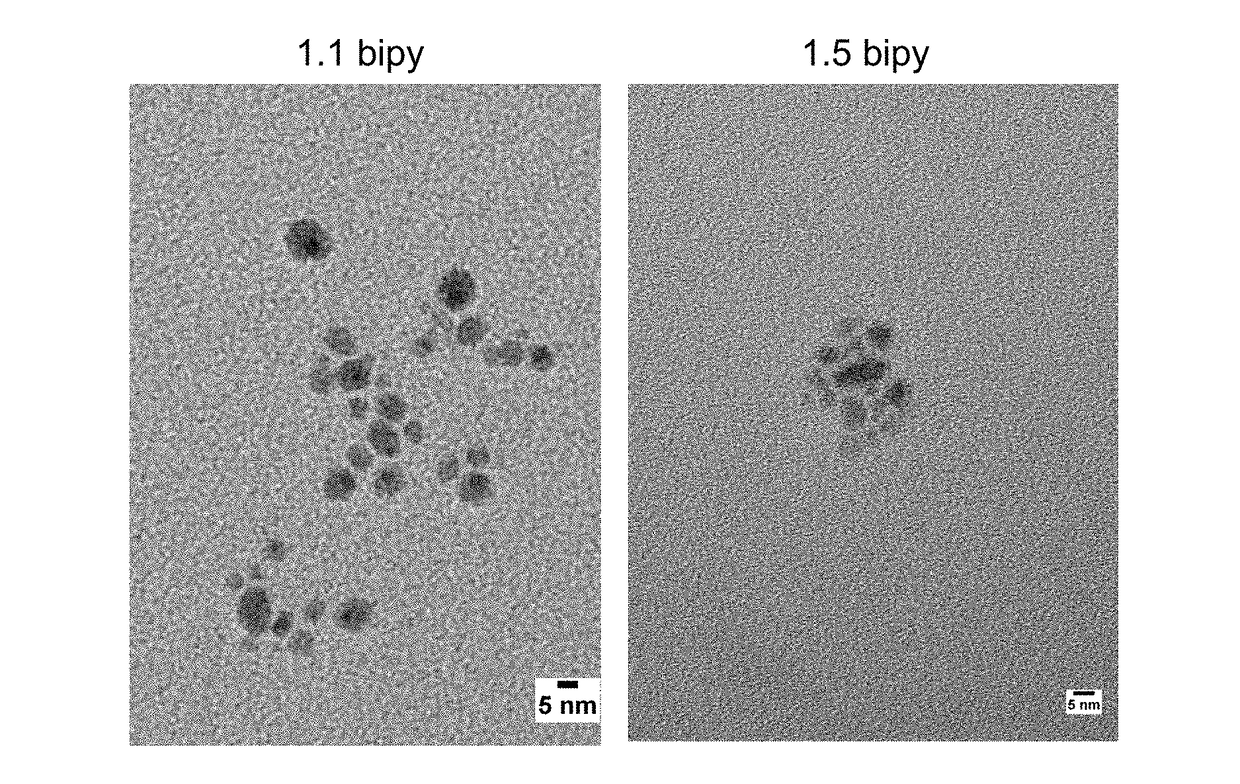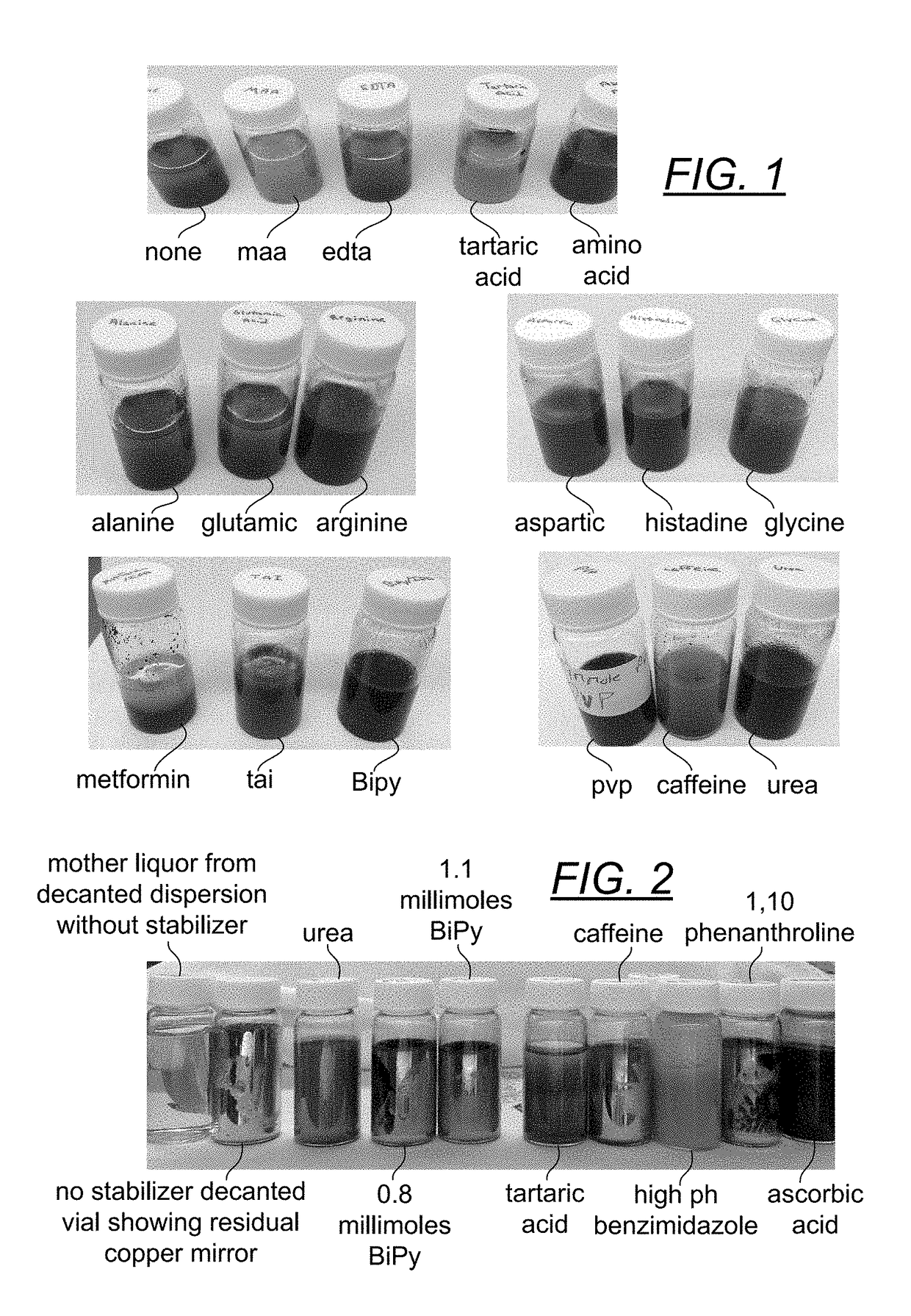Method of producing copper NANO particle colloidal dispersions
a colloidal dispersant and nanoparticle technology, applied in the direction of catalyst activation/preparation, metal/metal-oxide/metal-hydroxide catalyst, physical/chemical process catalyst, etc., can solve the problem of thwarting the reduction process, difficult to find or synthesize these metals in a free and reduced state, and difficult to use. , to achieve the effect of reducing the need for auxiliary solvents
- Summary
- Abstract
- Description
- Claims
- Application Information
AI Technical Summary
Benefits of technology
Problems solved by technology
Method used
Image
Examples
example 1
[0071]Example 1 exemplifies the results of a series of experiments screening various candidate stabilizers. A five ml aliquoit of a 0.1 M solution of CuCl22H20 (0.5 mmole) in ethanol was placed into each of nineteen 20 ml scintillation vials. To each vial was added 1 mmole of a different stabilizer dissolved in 7 ml of ethanol. Then 2 millimoles of NaBH4 (76.6 mg) were added with stirring to observe which compounds produced copper particles, how fine or coarse the particles were and whether the particles were suspended or not. The compounds in the FIG. 1 vials fall into three categories of stabilizers for metallic copper—good, moderate to poor and very poor or non-stabilizer. The good stabilizers included ascorbic acid and PVP (which were already known), as well as urea, 2,2′-bipyridine (i.e., BiPY) and benzimidazole. The moderate to poor stabilizers included carboxylic acids such as EDTA (large particles), tartaric acid (brown large particles) and the amino acids alanine, glutamine...
example 2
[0073]We had concerns that the reducing agent sodium borohydride was giving a copper boride adduct and not fully reduced copper, and so the next set (FIG. 2) of experiments were carried out with hydrazine, N2H2 (which oxidizes to nitrogen and hydrogen gas). The use of a chloride anion for the copper salt provides Cl— in the reaction, which over time, drops the pH of the system very low and the reduced metal becomes oxidized. Thus, the copper salt of choice became the acetate which did not suffer this problem.
[0074]Into a 20 ml scintillation vial were placed 1 mmole of copper acetate (200 mg in six ml of 18 megaohm deionized water). Six ml of isopropyl alcohol and six ml of propylene glycol were also added to the vial as well as 1.1 mmole of various selected stabilizers. The reduction was carried out by 2.5 mmoles (0.5 ml) of a 35% hydrazine solution. FIG. 2 displays the results obtained two days after the initial reaction.
[0075]The no stabilizer control (first two vials) printed out...
example 3
[0076]Twenty nine candidates were evaluated as stabilizers on the surface of pure copper 1-5 um flakes. These candidates, as shown in FIG. 3, fall into three broad classes: no effect, reducing agents that are also Cu2+ ligands and good ligands for Cu0. The reaction conditions are 1.5 mmole Cu flakes, 3 mmole stabilizer in 1.35 mmole IPA and 3.35 mmole of carbitol at 40 degrees Celsuis. In the first class (no visible effect) we find the compounds: hydroxyl amine, hexamethylenetriamine, pyridine, ascorbic acid, histadine, arginine, Jeffamine T403, triethylamine, and triethanolamine. In the second category, wherein the compound reduced the surface oxide on the copper flakes and liganded with the resulting Cu2+ ion to form a colored charge transfer complex we find: ethanolamine, Trishydroxymethylamino methane, N,N-dimethylethylenediamine, N,N, N′N′ Tetramethylethylene diamine , EDTA, 1-amino 2-propanol, 3-amino1-propanol, both 1,2 and to a lesser extent 1,3-diaminopropane, 1,2-diaminocy...
PUM
| Property | Measurement | Unit |
|---|---|---|
| particle size | aaaaa | aaaaa |
| temperatures | aaaaa | aaaaa |
| particle sizes | aaaaa | aaaaa |
Abstract
Description
Claims
Application Information
 Login to View More
Login to View More - R&D
- Intellectual Property
- Life Sciences
- Materials
- Tech Scout
- Unparalleled Data Quality
- Higher Quality Content
- 60% Fewer Hallucinations
Browse by: Latest US Patents, China's latest patents, Technical Efficacy Thesaurus, Application Domain, Technology Topic, Popular Technical Reports.
© 2025 PatSnap. All rights reserved.Legal|Privacy policy|Modern Slavery Act Transparency Statement|Sitemap|About US| Contact US: help@patsnap.com



